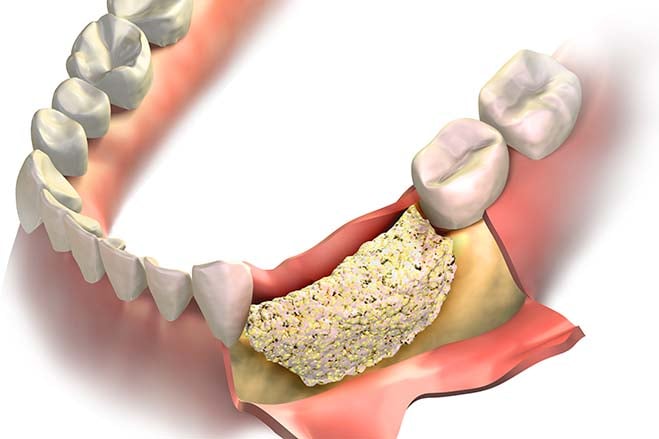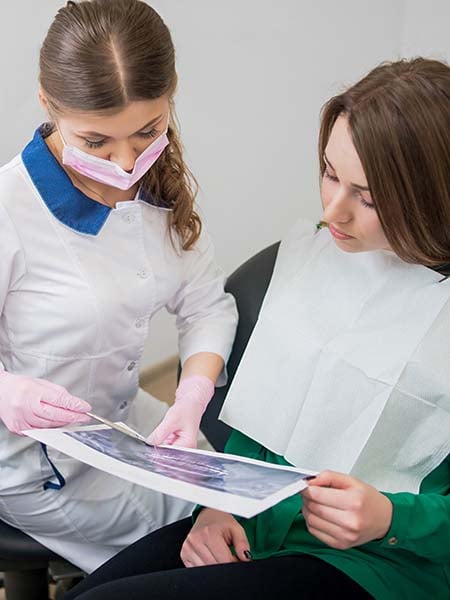.svg)
.svg)
.svg)
.svg)

Bone Grafting
Bone grafting is a procedure used to rebuild or augment bone in the jaw, often to support dental implants or repair bone loss. It involves placing a bone graft material in areas where bone density is insufficient, stimulating new bone growth and providing a strong foundation for future dental work. This helps restore the structure and stability needed for a healthy oral environment.
What is Bone Grafting?

What is Bone Grafting?
It is a procedure to repair or rebuild bone loss to secure over your jaw bone to recreate its height and thickness that have been previously lost due to:
- Gum disease;
- Previous tooth extractions;
- Other jaw conditions, e.g. cysts or tumours in your jaw.
Do I Need a Bone Graft?
- To increase bone volume for a strong foundation into which dental implants can be placed;
- To treat gum disease;
- For orthognathic surgical procedures;
- To address face trauma or injury;
- To replace a missing tooth.
Do I Need a Bone Graft?

Material for Bone Grafting
- Autografts: Bone that is taken from your own body, e.g. from another part of your jaw;
- Allograft grafts: Bone is taken from another human being;
- Xenografts: Bone that is taken from another species that is not human, e.g. bovine sources;
- Alloplastic bone grafts: Synthetic bone.
Your dentist will discuss with you which type of material will suit your situation the best.
Material for Bone Grafting

What Does the Procedure Involve?
Stage 1: Consultation
- Your dentist will inform you at your treatment consultation if bone grafting is required, based on information from X-rays and CBCT scans, and your proposed treatment.
Stage 3: Post-Operative Care
Recovery from bone grafts depends on the size of the graft. After the procedure, your dentist will give you instructions on how to look after your mouth.
You may feel some pain after the procedure but pain medications will be administered to reduce the discomfort.
Stage 2: Bone Grafting Procedure
-
Before the procedure, you will be given general anaesthesia. You ma also be placed under prior IV sedation or General Anaesthesia depending on your concerns and agreed individualised treatment plan.
-
Firstly, an incision will be made in the skin above where the graft will be placed. We will then shape the donated bone to fit the area. The graft will be held in place using any of the following: pins, plates, screws, wires, cables.
-
After which, the incision will be stitched and bandaged. A cast or splint may be used to support the bone while it heals. Usually, casting is not necessary.
What Are the Risks Involved?
- Pain;
- Swelling;
- Nerve injury;
- Rejection of the bone graft;
- Inflammation;
- Blood clots.
What Are the Risks Involved?

The Nuffield Dental Clinic Network In Singapore
Seletar Dental
Nuffield Dental Seletar
Greenwich V
1 Seletar Road #01-07/08
Singapore 807011

Kovan Dental
Nuffield Dental Kovan
Simon Plaza
2 Kovan Road #01-03
Singapore 548008

Serangoon Dental
Nuffield Dental Serangoon Gardens
Serangoon Garden Estate
57 Serangoon Garden Way
Singapore 555953

Siglap Dental
Nuffield Dental Siglap
The Domain
914 East Coast Road #01-03
Singapore 459108

Bedok Dental
Nuffield Dental Simpang Bedok
East Village
430 Upper Changi Road #01-64
Singapore 487048

Holland Village Dental
Nuffield Dental Holland Village
7 Holland Village Way #03-16
Singapore 275748

Jurong East Dental
Nuffield Dental Westgate
Westgate
3 Gateway Dr #04-32
Singapore 608532

HarbourFront Dental
Nuffield Dental HarbourFront
HarbourFront Centre
1 Maritime Square #02-64A
Singapore 099253

Orchard Dental
Nuffield Dental Jewel
Wheelock Place
501 Orchard Road #05-01
Singapore 238880

Raffles Place Dental
Nuffield Dental Raffles Place
One Raffles Place
1 Raffles Place #05-19
Singapore 048616


Book an Appointment
Fill out the form for any request or questions you have and we will contact you within one working day..


Why Choose Nuffield Dental?
Nuffield Dental is a one-stop, multi-disciplinary dental care centre. At Nuffield, we put you first. We believe in providing personalised service for each patient.
Nuffield Dental is a one-stop, multi-disciplinary dental care centre. Here at Nuffield Dental, we pride ourselves of our personalised oral care for each and every one of our patients. We need to make sure you get all the help you need to make your dental procedures comfortable, accessible and seamless.

Our dentists have a special interest inoral maxillofacial surgery and are accredited dental providers who have been helping patients achieve confident smiles.
Articles
The newest and best lifestyle articles selected by our editorial team.

- 17 Nov 2025
- 2 mins read
Current scientific evidence does not show a conclusive connection between intact dental amalgam fillings and symptoms such as brain fog, chronic...

- 17 Nov 2025
- 2 mins read
The Minamata Convention on Mercury established 2034 as the global target year to end the use of dental amalgam. While this may seem gradual, the...

- 17 Nov 2025
- 2 mins read
Dental amalgam has been used in restorative dentistry for more than 150 years. It has long been regarded as a durable and practical material....
.png?width=2223&height=447&name=Background%20(4).png)

.png)

.png)



